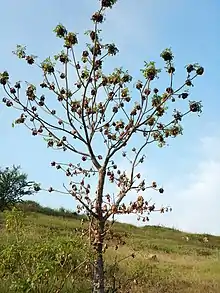| Amphipterygium adstringens | |
|---|---|
 | |
| Scientific classification | |
| Kingdom: | Plantae |
| Clade: | Tracheophytes |
| Clade: | Angiosperms |
| Clade: | Eudicots |
| Clade: | Rosids |
| Order: | Sapindales |
| Family: | Anacardiaceae |
| Genus: | Amphipterygium |
| Species: | A. adstringens |
| Binomial name | |
| Amphipterygium adstringens | |
Amphipterygium adstringens, the cuachalalate is an ancient medicinal plant that has been commercially used in Mexico for centuries. Because of its ever-growing popularity and since the most sought after part of the plant is its bark, the cuachalalate was as of 2004 considered an endangered species.[1] The Amphipterygium adstringens tree's height ranges from 4–8.5 m high. The distinguishing factor of this tree is its bark. Its bark is wrinkled, grayish in color and verrucose, with corky protuberances. Its branches are usually covered with scars of fallen leaves and may be bare or covered with fine hair-like structures. Its leave arrangements is imparipinnate with petioles that average 5.4 cm in length. It usually has 3-7 leaflets leaf. These leaflets have a cuneate base and an obtuse or rounded apex, its margin is dentate or crenate. A. adstringens can be differentiated from the other members of the Amphipterygium genus by the shape of its terminal leaflets, which is spathulate, and has dentate margins on the distal half of the leaflet.[2]
Distribution
Amphypterygium adstringens is distributed in central and southern Mexico in deciduous forests,[1] near the mountain and pacific slope regions, in the southern center part of the State of Jalisco, Michoacán, Morelos, Estado de Mexico, Puebla, Guerrero and Oaxaca. This plant usually blooms in the summer, from June to August, and tends to fructify (produce fruits) from August to January.[2]
Habitat and ecology
Amphipterygium adstringens grows in hot temperatures in deciduous jungles or Quercus and Ilex forests.[1]
Flowers and fruit
The male inflorescence is about 8.6 cm long. The male flower is actinomorphic. Its floral peduncle averages at .95 cm in length. There are 6-8 sepals on the flower all ranging from 1.2mm-2mm, these are tomentose (covered densely with hair at youngness), but at maturity they are pilose (the hair elongates and softens forming a plush surface). The stamen is short, with a filament averaging at only .28mm in length. The anthers, like the mature sepals, are also covered with long, fine hairs.
The female inflorescence is in raceme about 1.3 cm in length. These generally contain 2-4 flowers. The pistils are bifurcate. The style is cylindrical and about 2–3 mm long.[2]
Amphipterygium adstringens is dioecious, with male and female flowers on separate individuals.[3]
Medicinal
Cuachalalate is a legendary plant in Mexico believed to have curative effects. The most sought after part of the plant is its bark. This bark is believed to cure malaria, stomach cancer, gastric ulcers and kidney sicknesses.[2] Many people in Mexico also tend to use the Cuachalalate to harden their gums.[4]
References
- 1 2 3 "Boletín 10 y 11". Archived from the original on 2010-10-12. Retrieved 2012-05-01.
- 1 2 3 4 "A revision of the genus Amphipterygium (Julianiaceae)" (PDF). Ibugana.cucba.udg.mx. pp. 27–47. Retrieved 16 March 2022.
- ↑ Bachelier, Julien B.; Endress, Peter K. (2007). "Development of Inflorescences, Cupules, and Flowers in Amphipterygium and Comparison with Pistacia(Anacardiaceae)". International Journal of Plant Sciences. 168 (9): 1237–1253. doi:10.1086/521795. S2CID 83544619.
- ↑ Standley, Paul Carpenter (1920). Trees and Shrubs of Mexico pt.3. New York: Washington, Govt. Print. Off. p. 673. ISBN 1151260541.